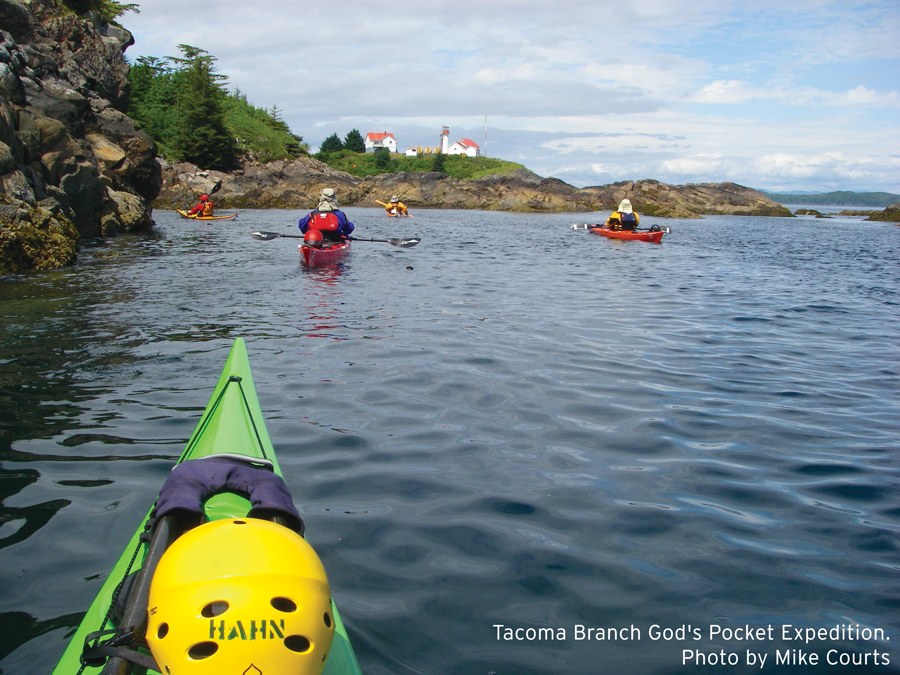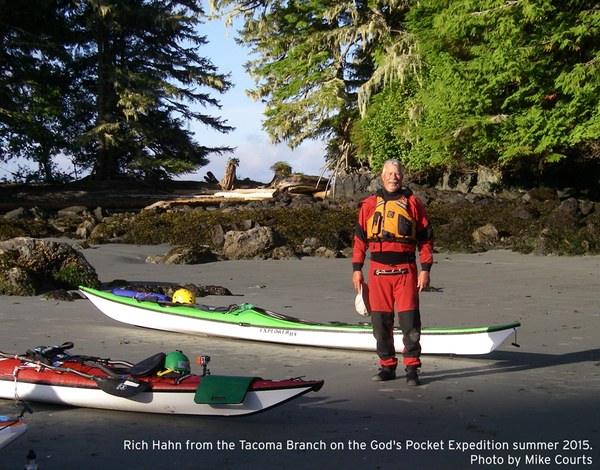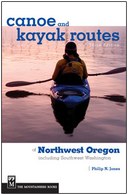
by Mike Courts, Tacoma branch and Will Greenough, Olympia Branch
Party separation at the mouth of Willapa Bay
A group of six of us set off from the north shore of the mouth of Willapa Bay. The tide was coming in, but was going to turn around noon and the swell outside was about six feet. We intended to cross over to Leadbetter Point, enjoy the beach there for lunch and then return in the afternoon. We had four people with lots of experience in coastal paddling (surf conditions) and two with much less experience but were strong paddlers.
The trip went well on the way over, and we had an enjoyable lunch on the beach. We discussed the tide, which was outgoing by then, and that there would be some fun sheltered wave conditions in the shallows initially on the way back. But we failed to discuss the potential hazards of the outgoing tide against the incoming swell as we got over to the main channel nearer the north shore.
Our path took us too close to the hazard area of overfalls and breaking surf and the party got separated into three groups of two while performing multiple rescues in difficult conditions. Each pair did have operational VHF radios, but one pair was not able to reach the other two. The two parties who were in communication made the decision to contact the coast guard immediately to let them know of the situation and that we would provide an update once we got back to the launch. Fortunately, we were able to reach the missing pair on VHF after about 15-20 minutes and let the coast guard know that all was okay.
My group was not able to make it back to the launch, but landed a couple of miles west along the beach. The VHF was essential to ensure all was okay and to coordinate getting back to the launch point.
Navigating remote areas with lots of traffic
Sea kayaking is a unique discipline within The Mountaineers. Sea kayaking shares much with the climbing community in that it occurs in remote areas, participants often face hostile environmental conditions, and assistance in case of emergency may be difficult to get. A major difference in sea kayaking is that it sometimes takes place in heavily trafficked waters with significant volumes of pleasure craft and commercial maritime traffic. This proximity of boat and ship traffic creates special challenges for sea kayakers. Imagine climbing on I-5 during rush hour.
Communications for sea kayakers is critical for safety. Intra-group communications, weather updates, communications with pleasure and commercial vessels, and emergency or distress communications are all essential for safe paddling.
A well-equipped sea kayaker, particularly a trip leader, will have multiple sources of communications ranging from signal mirror, whistle, maritime flares and smoke, cell phone, and VHF radio. We are even beginning to see the appearance of satellite based communications systems useful in more remote areas.
The hand-held, submersible VHF radio is an indispensable tool for the sea kayaker. At the most basic level, the VHF radio allows for communications within a group of paddlers. Most often this will take place on channel 69, designated the pleasure channel and available for non-emergency or commercial communications.
The importance of communication
Separation and clearance from pleasure craft and commercial vessels is essential. Sea kayaks operate low to the water, tend to be difficult to see and have limited speed and range.
The VHF radio is useful for hailing pleasure craft, either to summon emergency or non-emergency assistance or to alert the traffic to the presence of kayakers.
Of particular importance when operating in waters frequented by commercial traffic is communications with commercial vessels or agencies like VTSPS (Vessel Traffic Service Puget Sound).
According to USCG, “The purpose of Vessel Traffic Service Puget Sound is to facilitate the safe, secure and efficient transit of vessel traffic to assist in the prevention of collisions or groundings that could cost lives, property damage, or subject the pristine waters of the Salish Sea to environmental harm.”
Understanding how to use the VTS system allows sea kayakers to operate safely in waters shared by large volumes of commercial traffic.
Checking weather is another key use of a VHF radio. Most radios feature a one touch connection to marine weather broadcasts that consists of three weather channels. Getting a current weather forecast prior to launch and throughout a paddle is a key safety consideration.
The most critical use for a VHF radio is to summon emergency help. Most hand held submersible radios have a feature that allows for switching to the emergency channel “16” with one touch. This channel is monitored by the USCG and all vessels, commercial and pleasure. Although the VHF radio is a line-of-sight radio, with transmission distance limited to direct line of sight, the high density of pleasure craft and commercial vessels within the Puget Sound and British Columbia waters makes hailing emergency help fairly reliable. Maritime law requires all vessels receiving an emergency transmission to respond within their ability. For the sea kayaker, this is the most important reason to carry a hand held submersible VHF radio.
When paddling in a group, it is important to know who has a radio. Often, the group will have two individuals leave their radios on to monitor traffic and weather. Other members of the group will turn their radios on when instructed or when separated. Good practice includes a radio check of every radio in the group prior to launching.
From my own experiences, the VHF radio is an indispensable piece of equipment. The risk to sea kayakers from large vessels is significant and it would be foolhardy to operate in these remote regions with large open water crossings without reliable two-way communications.

Considerations when purchasing a VHF Radio:
Rechargeable vs Non-Rechargeable: Rechargeable radios are very convenient and save the expense and hassle of battery replacement. The ability to replace batteries can be preferable on extended trips when recharging a radio is impractical. Some of the newer rechargeable radios use a USB port for recharging and can be recharged from portable capacitors or solar cells.
Floating vs Non-Floating: The choice of a floating radio would seem an obvious choice, although they are generally significantly larger to create the volume required and often have reduced battery capacity. Many paddlers prefer the non-floating but tether the radio to their PFD.
Degree of Submergibility: Resistance to intrusion by water is listed using one of two standards; Japan industrial Standards (JIS) or IP Code (International Protection Rating).
Care for a VHF radio: Like any piece of equipment, proper care will affect longevity. Exposure of electrical equipment to salt water is a sure way to reduce useful life. Some kayakers store their radio in a water proof bag while on the water. Regardless, rinsing the radio after use and then storing in a large ziplock bag filled with uncooked rice is one good way to increase radio life.
Mike Courts and his wife live in DuPont and joined the Mountaineers in 2011. They graduated from the Tacoma Sea Kayaking Basic Course in 2012 and have been active paddlers ever since. Mike is a trip leader and also assist in teaching the Basic Course, Roll Class, and Incident Management Course. He is also the Outdoor Division Chairman for the Tacoma Branch and works as a ski instructor at the Summit at Snoqualmie. Additionally, Mike is a retired US Army Officer and was recently elected and is now serving as the Mayor of DuPont.
 Mike Courts
Mike Courts
